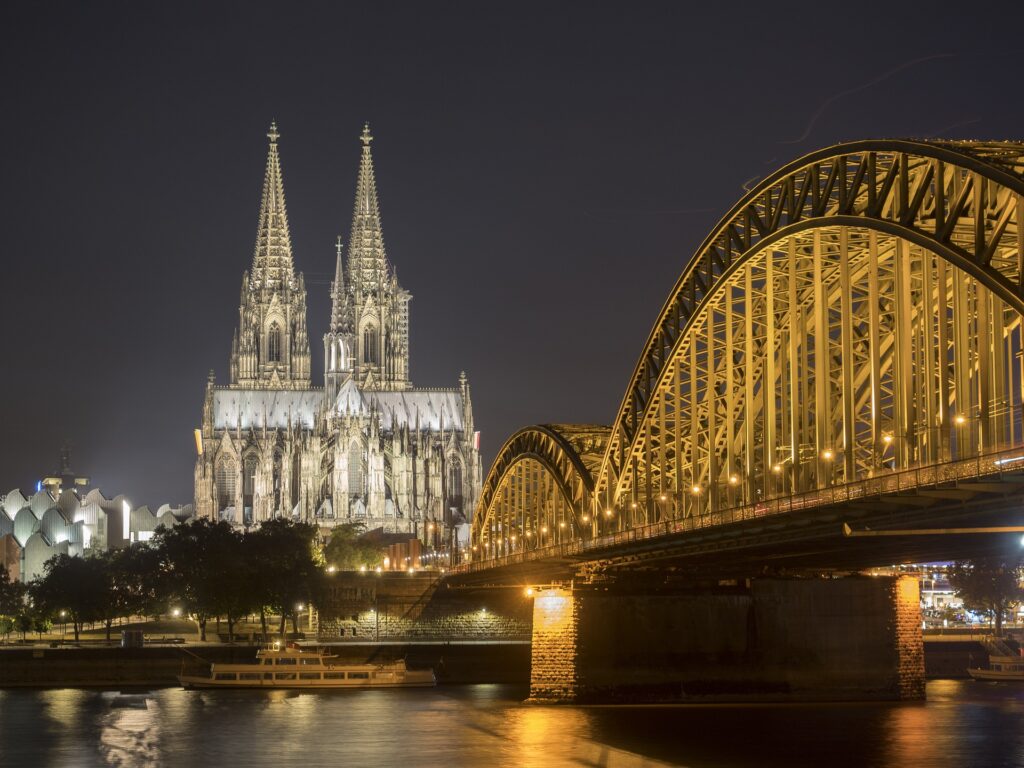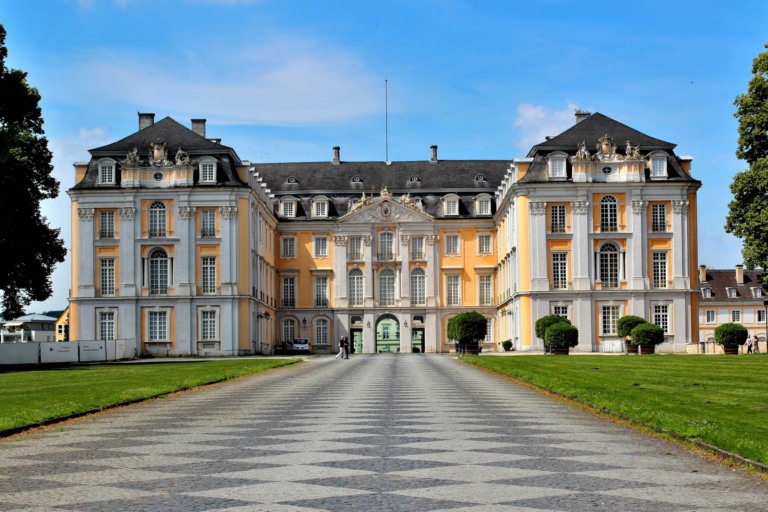Cologne Cathedral was begun in 1248, but it was not completed until 1880, having been built in stages over the course of seven centuries. This is a great example of how strong European Christianity is, even if you don’t care about its beauty or the works of art it holds. Kölner Dom is the name of the church in Cologne, Germany, that is part of the Catholic Church. It is where the Archbishop of Cologne lives and where the Archdiocese of Cologne runs its business. Its official name is “Hohe Domkirche Sankt Petrus,” which means “Cathedral Church of St. Peter” in English.
Cologne Cathedral Facts
Kölner Dom is a famous example of Catholicism and Gothic architecture in Germany. In 1996, it was named a UNESCO World Heritage Site. It is the most popular attraction in Germany, with about 20,000 people going there every day. At 157 m (515 ft), the cathedral is the largest twin-spired church in the world, the second-tallest church in Europe after Ulm Minster, and the third-tallest church in the world overall.
It has the second-tallest towers and is the biggest Gothic church in Northern Europe. The cathedral has the biggest front of any church in the world because of its two huge domes. The choir is 3.6 times as tall as it is wide, which is more than any other medieval church. The building of Cologne Cathedral started in 1248 and stopped around 1560. Around 1814, people started trying to finish the building, but the project didn’t get enough money until the 1840s.
In 1880, the building was finished in its original medieval style. Medieval builders in Cologne planned a grand building to hold the reliquary of the Three Kings and make it fit for its role as the Holy Roman Emperor’s place of prayer. Even though it wasn’t finished during the Middle Ages, Cologne Cathedral is now a “masterpiece of exceptional intrinsic value” and “a powerful testament to the strength and persistence of Christian belief in medieval and modern Europe.”
History of the Cologne Cathedral
The current Cologne Cathedral was built on the site of many earlier structures when the foundation stone was laid in 1248. The first may have been a place to store grain, and Mercurius Augustus may have built a Roman chapel to replace it. From the 4th century on, however, Christian buildings were built on the site. The first bishop of Cologne, Maternus, built a square building called the “oldest cathedral” on the site. At the east end of the current cathedral, there was a baptistery that stood alone and was built in the 7th century. It was torn down in the 9th century so that the second cathedral could be built.
During excavations of the current church, graves were found in the oldest part of the building. These included the grave of a boy who had a lot of grave goods and the grave of a woman who most people believed to be Wisigard. People think that both graves are from the 6th century. Today, the only things left are the ruins of the baptistery and the cylindrical baptismal font. In 818, the “Old Cathedral,” the name of the second church, was finished. It burned down on April 30, 1248, while workers were tearing it down to make room for a new church.
Cologne Cathedral Construction
In 1164, Rainald of Dassel, the Archbishop of Cologne, bought the remains of the Three Kings that the Holy Roman Emperor Frederick Barbarossa had taken from the Basilica of Sant’Eustorgio in Milan, Italy. The relics are very important to religion, and people come from all over Christendom to see them. Church leaders thought it was important that they had good places to live, so they started a building program in the new Gothic style, based on the French cathedral of Amiens.
On Saturday, August 15, 1248, Archbishop Konrad von Hochstaden put the first stone in place. The eastern arm, which was finished under Master Gerhard’s direction, was dedicated in 1322 and closed off with a makeshift wall so that it could be used while work continued on the rest of the cathedral. The choir has 84 misericords from this building phase.
Master Michael began work on the west front around the middle of the 1400s. When this work was done in 1473, the south tower was finished up to the level of the belfry and topped with a huge crane that stood out on the skyline of Cologne for 400 years. Between the west front and the eastern arm, some work was done on the building of the nave, but this also stopped in the 16th century.
Cologne Cathedral Built
Finishing Cologne Cathedral in the 19th Century: With the Romantic interest in the Middle Ages in the 19th century and the finding of the original plan for the facade, the Protestant Prussian Court worked with the church to finish the cathedral. It was done with the help of the community. The Central-Dombauverein, which was started in 1842, raised two-thirds of the huge costs, and the Prussian state paid for the last third. The state saw this as a way to get along better with the many Catholic subjects it had gained in 1815. After 1871, it was also seen as a way to show German nationalism.
Work on the cathedral started again in 1842, using iron roof girders and the original design from the medieval plans and drawings that were still around. In the 1870s, the bells were added, and the largest one is called St. Petersglocke. The nave was finished, and the towers were built. On August 14, 1880, 632 years after building started, the largest cathedral in Germany was finally finished. This was a big event for the whole country. During the party, Emperor Wilhelm I was there. It was the tallest building in the world for four years, until the Washington Monument was finished. It was 157.38 meters (516.33 feet) tall.
Architecture of the Cologne Cathedral
The layout of Cologne Cathedral was very similar to that of France’s Amiens Cathedral, as were the style and width-to-height ratio of the center nave. As is typical for Gothic churches, the plan is in the shape of a Latin Cross. It has two aisles on each side, which help hold up one of the largest Gothic vaults in the world. It is almost as tall as Beauvais Cathedral’s vault, which fell down in large parts. French flying buttresses support the vault’s outward push from the outside. At the eastern end, there is only one ambulatory, and the second aisle ends in a chevet with seven cells that spread out from it.
Treasures in the Cologne Cathedral
The high altar, which was put in place in 1322, is one of the cathedral’s most valuable parts. The top is a thick slab that is 15 feet (4.6 m) long and made of black marble. On the front and sides, there are spaces made of white marble that hold figures, with the Coronation of the Virgin in the middle. The Shrine of the Three Kings is the most famous piece of art in the church.
Philip von Heinsberg, who was archbishop of Cologne from 1167 to 1191, asked Nicholas of Verdun to make it in 1190. Tradition says that it holds the bones of the Three Wise Men. Frederick Barbarossa got their remains when he took over Milan in 1164. The shrine is a big reliquary in the shape of a basilican church. It is made of bronze and silver, is gilded, and has architectural details, sculptures of people, enamels, and precious stones on it. When the shrine was opened in 1864, bones and clothes were found inside.
Music in church:
Klais Orgelbau built the transept organ in 1948 and the nave organ in 1998, both of which are in Cologne Cathedral. Josef Zimmermann, Clemens Ganz (1985–2001), and Winfried Bonig (2001) have all played the organ in cathedrals.
Cologne Cathedral Bells
There are eleven church bells in the cathedral. Four of them are from the Middle Ages. The first was the 3.8-ton Dreikonigsglocke (“Bell of the Three Kings”), which was made in 1418, put up in 1437, and remade in 1880. Two of the other bells, the Pretiosa (10.5 tons) and the Speciosa (5.6 tons), were put in place in 1448 and are still there today.
At the time, the Pretiosa was the biggest bell in the Western world. In the 19th century, as the building was nearing completion, there was a push to add more bells. The 24-ton St. Petersglocke, also called the “Bell of St. Peter” or “Decke Pitter” in the Kolsch language or “Dicker Pitter” in everyday speech, was cast in 1922. This bell only rings on eight important holidays, like Christmas and Easter.
World War II and what happened after it:
During World War II, fourteen bombs hit the cathedral from the air. It was badly damaged, but it still stood in a city that had been totally destroyed. The twin towers made it easy for Allied bombers to find their way to their targets. A German medium tank called a Panther was sitting next to a pile of rubble near a train stop and the twin spires of the Cologne Cathedral. After the Panther was destroyed, it was put on display at the bottom of the cathedral for the rest of the war in Europe.
In 1956, the damage from the war was fixed. In 1944, a poor-quality brick from a nearby destroyed building was used to fix up part of the northwest tower. This was left as a memory of the war until 2005, when it was fixed up to look like it did before. Archaeological digs began in 1946 under the direction of Otto Doppelfeld to find out if the bombs had damaged the Dom’s foundations. They ended in 1997. One of the most important church excavations revealed information about older buildings that had never been known before.
As wind, rain, and smog slowly wear away at the stones, repair and maintenance work is always going on in the building, which is rarely without scaffolding. The Dombauhütte was set up to build the cathedral and keep it in good shape. It is said to hire the best stonemasons in the Rhineland, and the Dombauverein still pays for half of the costs of repair and upkeep.
Cathedral of Cologne in the 21st century
Pope Benedict XVI went to the church on August 18, 2005, as part of his apostolic visit to Germany for World Youth Day 2005. During this time, about a million pilgrims went to the church. On August 25, 2007, the church got a new stained-glass window in the south transept. The German artist Gerhard Richter made the 113-square-meter (1,220-square-foot) glass piece, and gifts paid the €400,000 price.
It is made up of 11,500 pieces of colored glass of the same size that look like pixels. A computer randomly put them together to make a bright “carpet.” Since the original window was destroyed during World War II, clear glass has been used to temporarily fill the space. Cardinal Joachim Meisner, who was then the cathedral’s archbishop and wanted a picture of Catholic heroes from the 20th century for the window, did not show up for the event.


